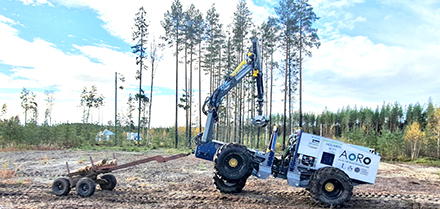A study published in the Journal of Field Robotics has assessed the world’s first unmanned machine designed for autonomous forestry operations. Source: Timberbiz
Investigators demonstrated that using computer vision, autonomous navigation, and manipulator control algorithms, their newly developed machine can safely, accurately, and efficiently pick up logs from the ground and manoeuvre through various forest terrains without the need for human intervention.
The autonomous terrain vehicle was designed and built at Luleå University of Technology in Sweden.
It is the first time in world history that forwarding is done completely without human intervention. The researchers behind the successful trial see it as an important step towards more sustainable forestry.
“This will redraw the map for the industry and how other players in the area view operations such as these. We have worked extremely intensively with this test, and it feels very nice that it actually works,” Magnus Karlberg, professor at Luleå University of Technology said.
The research represents a significant milestone in the field of autonomous outdoor robotics, which could reduce the need for human labour, thereby increasing productivity and reducing labour costs, while also minimizing the environmental impact of timber harvesting.
The autonomous shovelling took place in Hörnefors in Västerbotten, in collaboration with the Forestry Technology Cluster and the Swedish University of Agricultural Sciences.
By being programmed to perform the work on its own, the forestry machine was able to pick up and transport logs to the intended collection point. A job usually performed by forwarder drivers in machines built for the purpose, but this time the people could stand by and watch.
The 10-ton machine, which is now also used in the Arctic Off-Road Robotics Laboratory, can be controlled with a remote control but is also programmed to perform work entirely on its own, as in the test with autonomous forwarding.
The machine is currently powered by biodiesel and is built without a cab, but with a hydrostatic driveline, forest crane, pendulum arms and sensors.
As early as 2014, researchers began sketching the machine, or off-road vehicle platform, which is a more correct name. Since then, the research team has worked to make the self-propelled vehicle as smart and robust as possible. A work that is now beginning to bear fruit.
“That a self-driving forest machine can handle such an advanced task is world-unique and opens up for major changes in the forest industry,” Prof Karlberg said.
“Even though it is still many years away, and will take place gradually, we are convinced that the technical development with smart autonomous forest machines is the future of forestry. We have shown that the technology exists, but there is of course a difference for us who look at this from a research perspective and commercial activities. We researchers can step into the future in a completely different way.”
The development of self-propelled forest machines is also an important step for more sustainable forestry thanks to the possibility of smaller and more energy-efficient machines that can also work much more gently in forest and land.
“Besides its short-term effect on forestry, the technological advancements that come with autonomous forestry machines have the potential to address current environmental issues. As demonstrated in this study, by embracing cutting-edge technologies like autonomous navigation and manipulation algorithms, the unmanned machine provides not only timber harvesting with greater efficiency but also promotes sustainable forestry,” said corresponding author Pedro La Hera, PhD, of the Swedish University of Agricultural Sciences.
“Automated operations can be highly accurate and effective in terms of collateral damage to adjacent ecosystems, which helps us to be more ecologically friendly than we currently are.”






